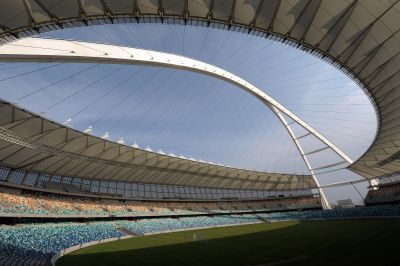2010 FIFA World Cup South Africa stadium guide

A guide to the 2010 FIFA World Cup stadiums in South Africa, including stadium capacity, construction dates, notable fixtures and alternative names.
Soccer City, Johannesburg
The largest stadium at the 2010 World Cup usually goes by the name of FNB Stadium, as a result of sponsorship from South Africa's First National Bank. FIFA rules prevent non-FIFA sponsors having a look-in on World Cup events so, like a few other stadiums, the venue for the first and final matches of the cup will be known as Soccer City.
Capacity: 94,000
Completed 1989, upgraded 2009
Notable fixtures: First match on June 11, quarter final on July 2, and final on July 11
http://www.soccercity2010.co.za
Ellis Park Stadium, Johannesburg
Although now usually known as the Coca Cola Park, Johannesburg's other big stadium was originally named after businessman J. D. Ellis who owned the original site before it became a sports venue in 1928. In 1979 it was knocked down and replaced with the current complex.
Capacity: 65,000 (usually 60,000)
Completion: 1982, upgraded 2008
Notable fixtures: Quarter final
http://www.ellispark.co.za
Moses Mabhida Stadium, Durban
Although initial plans referred to it as King Senzangakhona Stadium, in reference to a Zulu King, it was ultimately named after the former leader of the South African Communist Party, allied with the African National Congress. The stadium in Durban, on the west coast of South Africa, is one of five constructed especially for the 2010 World Cup.
Capacity: 70,000 (usually 54,000)
Completion: 2009
Notable matches: Semi final
http://fifaworldcup.durban.gov.za
Free State Stadium, Bloemfontein
The Free State Stadium, otherwise known as Vodacom Park, is home to the Free State Cheetahs and Central Cheetahs rugby teams, and soccer side Bloemfontein Celtic, whose white and green hooped kit colours match that of Glasgow's famous side. Substantial upgrades have taken place to increase capacity from the 36,500 that it was.
Capacity: 48,000
Completion: 1952, upgraded 2008
http://web.mangaung.co.za/en/fifaworldcup
Cape Town Stadium, Cape Town
Often referred to as Green Point Stadium, due to its location in Green Point which is one of the more well-off areas of coastal Cape Town. This makes it somewhat unusual among the new stadiums, surrounded as it is by a lush green golf course, and its unique circular glass roof is a first in stadium design.
Capacity: 68,000 (usually 55,000)
Completion: 2009
Notable fixtures: 2nd match of the opening day, quarter final, semi final
http://www.capetown.gov.za/en/2010
Mbombela Stadium, Nelspruit
Mbombela is named after a word in the Swati tribal language which means "lots of people in a small space" - an apt description of the typical World Cup stadium environment, which takes inspiration from famous examples of African wildlife: giraffe-like supports hold up the roof, while seats are decorated in a striped zebra pattern.
Capacity: 46,000
Completed 2009
Peter Mokaba Stadium, Polokwane
Named after the former leader of the African National Congress youth party, who was prominent in the campaign to end apartheid and became one of Nelson Mandela's deputy ministers. The stadium is almost entirely open air, though it remains to be seen whether any players will be able to punt a matchball right over the top tier during the four group matches hosted there.
Capacity: 46,000
Completion due January 2010
Nelson Mandela Stadium, Port Elizabeth
Port Elizabeth's brand new stadium is, of course, named after the Nobel Laureate and former President of South Africa who spent 27 years in prison as a result of his struggle for racial equality. The coastal stadium has been in use since July 2009 and hosted the South Africa vs Japan friendly soccer match in November that ended in a 0-0 draw.
Capacity: 46,500 (usually 44,000)
Completion: 2009
Notable fixtures: Quarter final, 3rd place play-off
http://www.nelsonmandelabay.gov.za/fifaworldcup
Loftus Versfeld Stadium, Pretoria
Named after Robert Loftus Versfeld, who founded organized rugby in the region and passed away in the stadium in 1932 after suffering a heart attack in the east stand, this is the oldest stadium in use during the FIFA tournament but of course has undergone significant upgrades since then, becoming one of the host sites during 2009's Confederations Cup.
Capacity: 54,800
Completed 1906, upgraded 2009
Royal Bafokeng Stadium, Rustenburg
Also known as the Royal Bafokeng Sports Palace, a community-owned complex and just outside Rustenberg, this colorful multi-purpose arena has added a cantilever roof with additional lighting and a large scoreboard suitable for hosting five group matches and a last-16 knockout in June 2010.
Capacity: 44,000
Completed 2000, upgraded 2009
http://www.bafokeng.com/present/2010-fifa-world-cup
Join our commenting forum
Join thought-provoking conversations, follow other Independent readers and see their replies
Comments
Bookmark popover
Removed from bookmarks